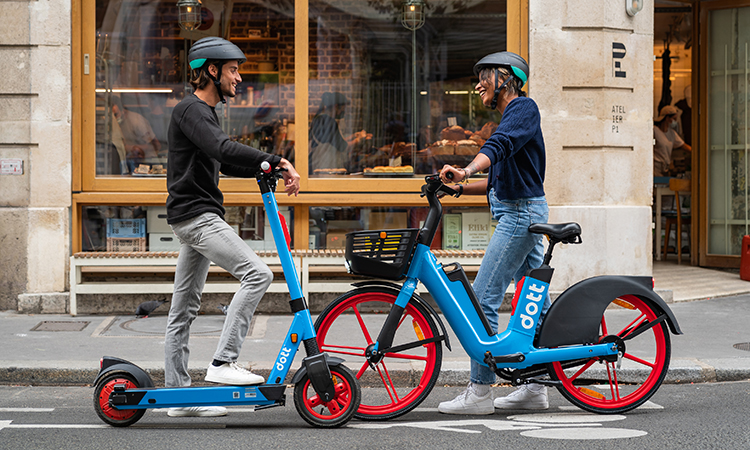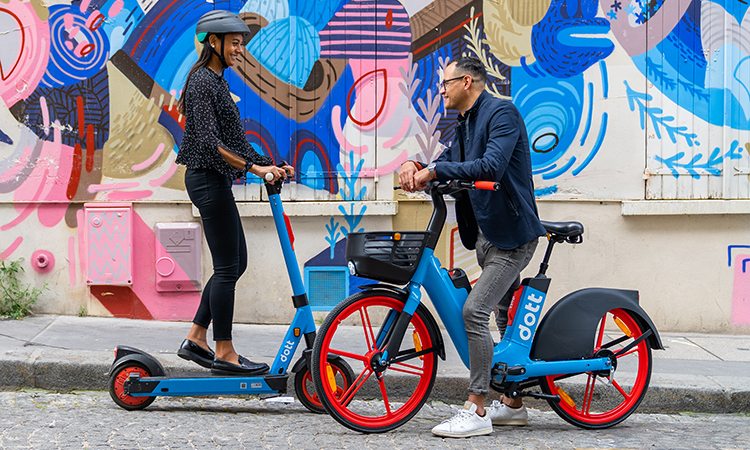Smart scooters: How technology enhances shared micro-mobility
- Like
- Digg
- Del
- Tumblr
- VKontakte
- Buffer
- Love This
- Odnoklassniki
- Meneame
- Blogger
- Amazon
- Yahoo Mail
- Gmail
- AOL
- Newsvine
- HackerNews
- Evernote
- MySpace
- Mail.ru
- Viadeo
- Line
- Comments
- Yummly
- SMS
- Viber
- Telegram
- Subscribe
- Skype
- Facebook Messenger
- Kakao
- LiveJournal
- Yammer
- Edgar
- Fintel
- Mix
- Instapaper
- Copy Link
Posted: 6 January 2022 | Maxim Romain - Dott | No comments yet
Technology has opened up the door for shared multimodal travel in our cities. Maxim Romain, Co-Founder and Chief Operating Officer at Dott, explains how technological connectivity is enhancing safety, driving efficiency and increasing accessibility to the company’s green e-bikes and e-scooters.


Credit: Dott
Across some of Europe’s cities, a transformation is underway. Cycle lanes are appearing; new speed limits are being enforced in city centres; and car-free and low emission zones are being adopted. We welcome all initiatives which make it easier for people to choose shared micro-mobility as their main way to get around a city, and these progressive steps are, of course, a driving force for the increase in demand that we are seeing across Europe for our e-scooters and e-bikes.
But, whilst these measures may have the biggest visual impact, the adaptation of micro-mobility isn’t entirely down to infrastructure. Technology plays a major part in keeping shared services safe for the riders, other road users and pedestrians.
Using technology to enhance safety
Internet connectivity allows us to have a deep understanding of where our vehicles are located and how they are being used. We want to ensure that our e-scooters and e-bikes are operated in line with local regulations and restrictions, so they are all fitted with speed restrictions aligned to the requirements of city authorities.
This covers general speed limits, but can be more tailored than that, with specific ‘go-slow’ zones where there might be a high density of pedestrians and a slower speed is more suitable. An example of this is in Paris, where low speed zones have been created in pedestrian areas to limit e-scooter speed to 10 km/h. We can even create ‘no-go’ zones, where the vehicle is no longer powered in specific areas that it is not deemed safe to operate. In close collaboration with city authorities, these speed measures can ensure that shared e-scooter and e-bike riders safely co-exist alongside pedestrians in compact locations.
In some cases, restrictions are more appropriate by time of day than location. For example, in Oslo, we have worked with the city authorities to ensure that our vehicles cannot be operated between the hours of 00:00 and 05:00, where the city had previously seen a higher number of accidents. Additionally, for new riders, we can set vehicles to operate at lower speeds during their initial journeys. This tool is particularly beneficial in markets which are new to e-scooters, where the population may not be familiar with the vehicle, and can help the user to become comfortable with moving around at a lower speed initially.


Credit: Dott – Technology has unlocked the ability for businesses such as Dott to operate whole fleets of shared e-scooters and e-bikes and shift the perception that every individual should purchase their own vehicle.
Smart Parking technology
We firmly believe that, for our service to be a success, we must work closely with the city authorities to ensure that our vehicles provide an effective solution to as broad a range of people as possible, without being a nuisance to any other city resident. Our ‘Smart Parking’ technology was thus developed as a measure to combat parking in wrong locations undertaken by a number of users.
Tracking the location of our vehicles, Smart Parking ensures that a journey on an e-scooter or e-bike can only be ended in a designated parking zone. Dott initially used this technology in Paris, where we now see 98 per cent of our vehicles parked correctly. The feature is also now in place in London, among other European cities. To succeed, a proportion of parking spaces must be given over from cars to become e-scooter and e-bike parking, meaning that, instead of a single car occupying that space for a large portion of time, these bays can then host a variety of vehicles throughout the day, helping to free our cities from cars.
In-app software educates and increases safe vehicle use
Dott also uses technology in the software of its app to ensure the safe use of its vehicles. In some cities, we are verifying driving licenses to prevent underage drivers. We have also built a series of e-learning modules, where new users must read a series of tips and guidance on the local regulations before being able to hire a shared vehicle.
Whilst these measures offer effective controls to encourage the safe use of our vehicles, we are continuing to explore new tools and initiatives to help us to improve. We are currently working closely with a data service called See Sense, which monitors the riding conditions of our e-scooters and collates the data to show areas that riders are more likely to swerve, break or encounter poor road conditions. This data can be shared with city authorities to help to make roads safer for all users. We are also exploring options for audible warnings when the scooter is in use to improve audibility, especially for visually impaired road users.
Connective technology allows multimodality
Beyond these safety uses, technology is the fundamental reason that shared services can operate. Connectivity has transformed whole industries, and now it is improving the way that we move around our cities. It allows us to know where our vehicles are located, so that we can move them if needed to where the demand is. We can monitor battery usage, and even predict maintenance based on patterns emerging over time, so that our engineers can work to prevent an issue, rather than waiting for it to happen.
This technology has unlocked the ability for businesses such as Dott to operate whole fleets of shared e-scooters and e-bikes and shift the perception that every individual should purchase their own vehicle. As we move towards multimodality, and offer a broader range of products, people can choose the type of transport that suits them best at any given time. This could be based on their journey, whether they have luggage, the weather or even their mood. As technology advances to help us to become even more efficient, the cost will be reduced for the user, so that they can benefit from the freedom, flexibility and convenience of a private vehicle, but with the affordability and accessibility of public transport.
Whether to enhance safety measures, or to provide an effective service, the technology embedded in both our hardware and software is fuelling our ambition to free our cities with clean rides for everyone.
Maxim Romain is the Co-Founder and Chief Operating Officer at Dott. Romain is French and was previously Ofo’s Head of EMEA, Wayfair Europe MD and previously worked for Decathlon Asia in operations and manufacturing. He holds a Master’s degree in Engineering from Ecole Centrale Lille and MBA at Insead.
Related topics
Connected & Autonomous Vehicles, Multimodality, On-Demand Transport, Vehicle & Passenger Safety
Related modes
Bikes & Scooters
Related organisations
Dott
Related people
Maxim Romain








